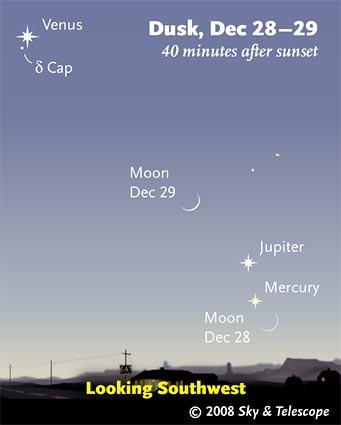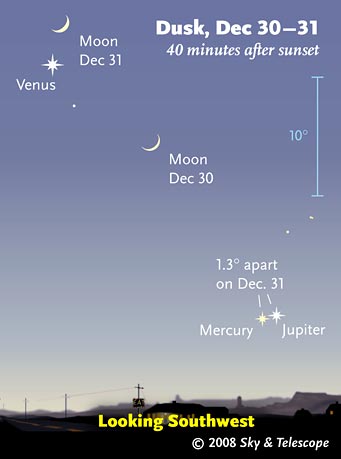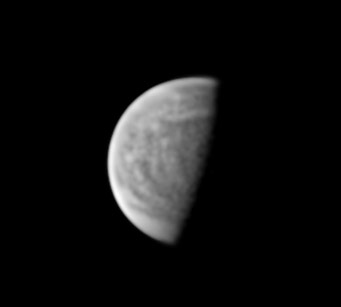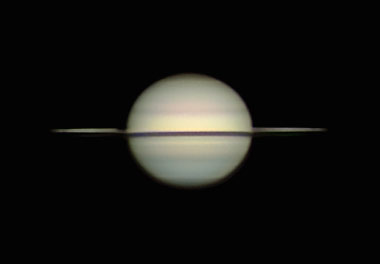Some daily events in the changing sky for December 26 – January 3.

By the time the thin crescent Moon returns to the evening sky, Mercury will be in better view below Jupiter. (These scenes are drawn for the middle of North America. European observers: move each Moon symbol a quarter of the way toward the one for the previous date.)
Sky & Telescope diagram
Friday, December 26
Saturday, December 27
Sunday, December 28
Monday, December 29

Watch the Moon advance toward Venus for their pairing on New Year's Eve. (These scenes are drawn for the middle of North America. European observers: move each Moon symbol a quarter of the way toward the one for the previous date. The blue 10° scale is about the size of your fist held at arm's length. For clarity, the Moon is shown three times actual size.)
Sky & Telescope diagram
Tuesday, December 30
Wednesday, December 31
Europeans are well placed for the best of both events above. Contributor David Likuski writes, "The Mercury-Jupiter conjunction is at about 14:40 Universal Time, while the Venus-Moon conjunction is about 17:25 UT. Therefore, 16:00 UT is about the middle of the two." This is around the time of sunset for London. "Overall, a good chunk of mainland Europe seems to have the good combination of darkness and altitude for Mercury" at the midpoint time between the two conjunctions.
Thursday, January 1
Also: the red long-period variable stars R Cygni, R Cassiopeiae, and T Cephei should be at their maximum brightnesses around now (6th to 8th magnitude).
Friday, January 2
Saturday, January 3
Want to become a better amateur astronomer? Learn your way around the constellations. They're the key to locating everything fainter and deeper to hunt with binoculars or a telescope. For an easy-to-use constellation guide covering the whole evening sky, use the big monthly foldout map in each issue of Sky & Telescope, the essential magazine of astronomy. Or download our free Getting Started in Astronomy booklet (which only has bimonthly maps).

The Pocket Sky Atlas plots 30,796 stars to magnitude 7.6 — which may sound like a lot, but that's less than one star in an entire telescopic field of view, on average. By comparison, Sky Atlas 2000.0 plots 81,000 stars to magnitude 8.5, typically one or two stars per telescopic field. Both atlases include many hundreds of deep-sky targets — galaxies, star clusters, and nebulae — among the stars.
Sky & Telescope
Once you get a telescope, to put it to good use you'll need a detailed, large-scale sky atlas (set of maps; the standards are Sky Atlas 2000.0 or the smaller Pocket Sky Atlas) and good deep-sky guidebooks (such as Sky Atlas 2000.0 Companion by Strong and Sinnott, the even more detailed Night Sky Observer's Guide by Kepple and Sanner, or the classic Burnham's Celestial Handbook). Read how to use them effectively.
Can a computerized telescope take their place? As Terence Dickinson and Alan Dyer say in their Backyard Astronomer's Guide, "A full appreciation of the universe cannot come without developing the skills to find things in the sky and understanding how the sky works. This knowledge comes only by spending time under the stars with star maps in hand and a curious mind." Without these, they note, "the sky never becomes a friendly place."
More beginners' tips: "How to Start Right in Astronomy".
This Week's Planet Roundup
Mercury (still magnitude –0.7) having a fine evening apparition low in the southwest after sunset, shining close to brighter Jupiter as shown in the scenes above. Watch their changing configuration from day to day. Mercury and Jupiter are closest, 1.3° apart, on December 31st. Bring binoculars.

Visually, Venus is pure white — any markings in its cloud deck are so subtle that there's always doubt about their reality. In ultraviolet light, however, it's a different story. And with stacked-video imaging, amateurs have been able to take extraordinary ultraviolet images like this. With Venus approaching dichotomy (half phase), veteran imager Don Parker of Coral Gables, Florida, captured this view in broad daylight on December 28, 2008, through an Astrodon UV Venus filter using a 10-inch Mewlon telescope at f/24.
Donald C. Parker
Venus (magnitude –4.4) is the "Evening Star" blazing in the southwest during and after twilight. It has a beautiful conjunction with the crescent Moon on New Year's Eve. In a telescope Venus is 20 arcseconds wide (barely a hundredth the diameter of the Moon) and slightly gibbous (59% sunlit).
Mars remains hidden deep in the glare of sunrise.
Jupiter (magnitude –1.9) is far to Venus's lower right. Look early and low; Jupiter now sets around twilight's end. Near it this week is fainter Mercury; see the twilight scenes above.
Saturn (magnitude +1.0, near the Leo-Virgo border) rises around 10 or 11 p.m. and is highest in the south before dawn. Don't confuse Saturn with similarly-bright Regulus 22° (about two fist-widths at arm's length) to its upper right after they rise, and directly to its right before dawn.

On Christmas night Richard Bosman in the Netherlands took this image of Saturn at its minimum ring tilt for this apparition, 0.8°. South is up. Bosman writes, "The northern part is still bluish. There were no storms or spots on display at this meridian. Remarkable is the beauty of the very narrow ring now at the minimum. The ring is not bright white but dull gray."
The Cassini Division is visible near the rings' ansae (ends). The shadow of the globe is cast on the ring's western (left) side just off the globe's edge. Even a small scope will show the very prominent black shadow that the rings are casting on the globe. Bosman used an 11-inch Celestron Schmidt-Cassegrain telescope and an ATK-2HS camera at 5:02 UT Dec. 26, 2008.
Saturn's rings are now nearly edge-on — and this may be the last chance in your life to see them so ghostly thin! A telescope shows that the rings have closed to only 0.8° from edge on, forming a hairline barely visible at all. The rings will start opening again a little in January and finally close to exactly edge-on next September — but at that time Saturn will be, unfortunately, in conjunction with the Sun.
Nor will Saturn be in good view for the next ring-plane crossing 15 years hence. The next one that'll be easy to view comes in 2038!
Uranus and Neptune (magnitudes 5.9 and 7.9, respectively, in Aquarius and Capricornus) are in the southwest right after dark. Neptune is passing by Venus. Use our article and finder charts online or the chart in the September Sky & Telescope, page 63. On the 27th, use the convenient chart for Neptune near Venus in the December Sky & Telescope, page 55.
Venus will go on to pass Uranus on January 22nd.
Pluto is hidden in the glare of sunrise.
All descriptions that relate to your horizon or zenith — including the words up, down, right, and left — are written for the world's mid-northern latitudes. Descriptions that also depend on longitude (mainly Moon positions) are for North America. Eastern Standard Time (EST) equals Universal Time (known as UT, UTC, or GMT) minus 5 hours.
To be sure to get the current Sky at a Glance, bookmark this URL:
http://SkyandTelescope.com/observing/ataglance?1=1
If pictures fail to load, refresh the page. If they still fail to load, change the 1 at the end of the URL to any other character and try again.
 0
0
Comments
You must be logged in to post a comment.